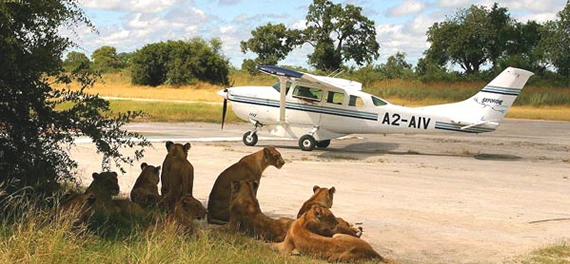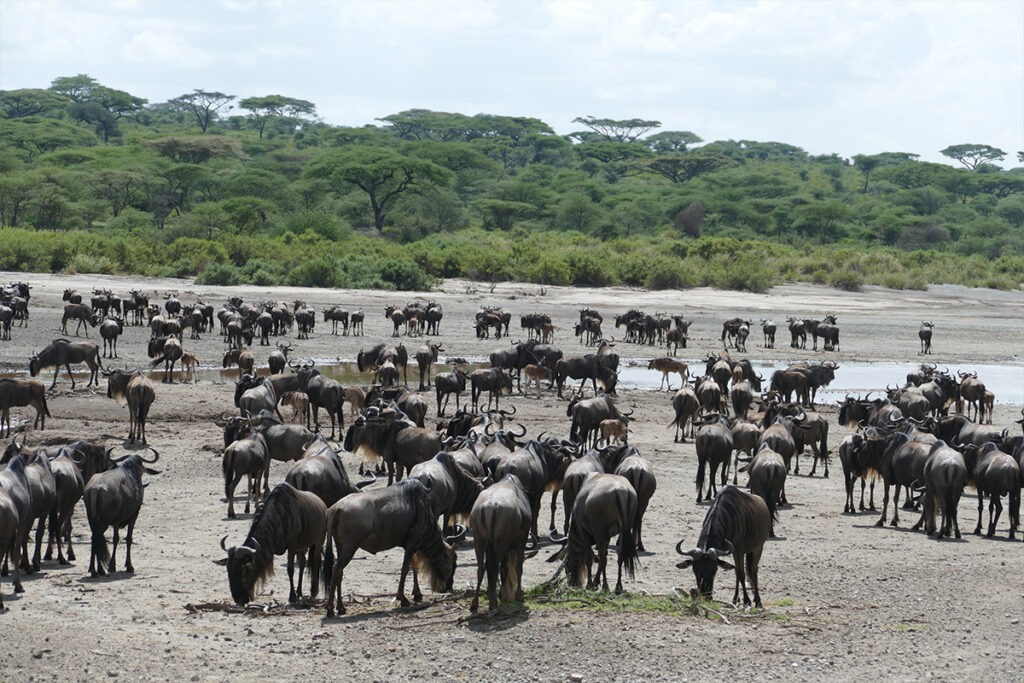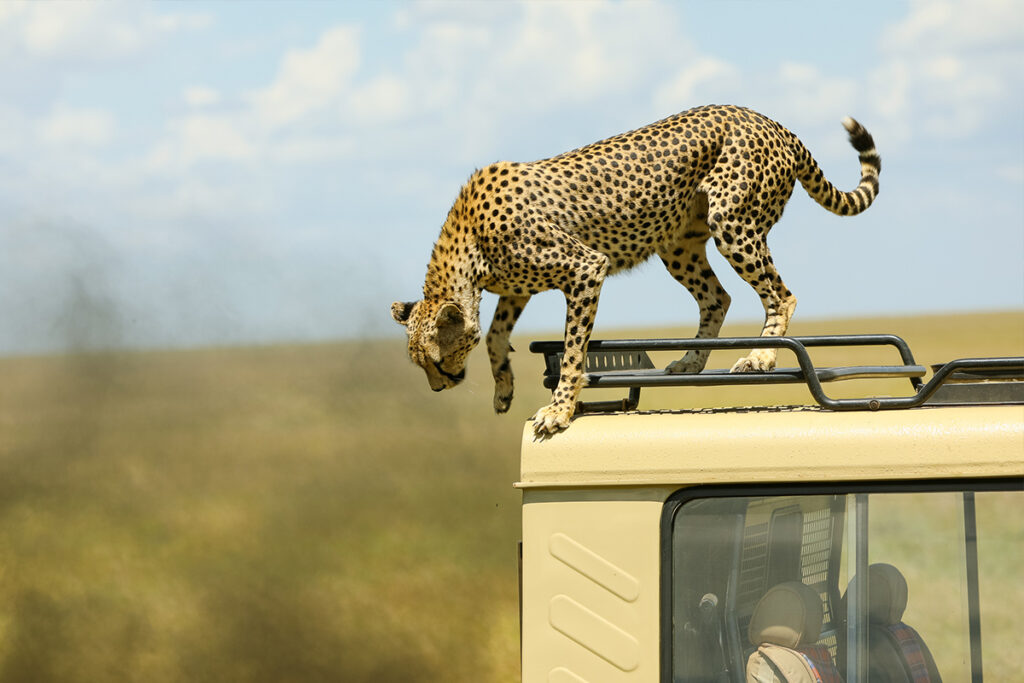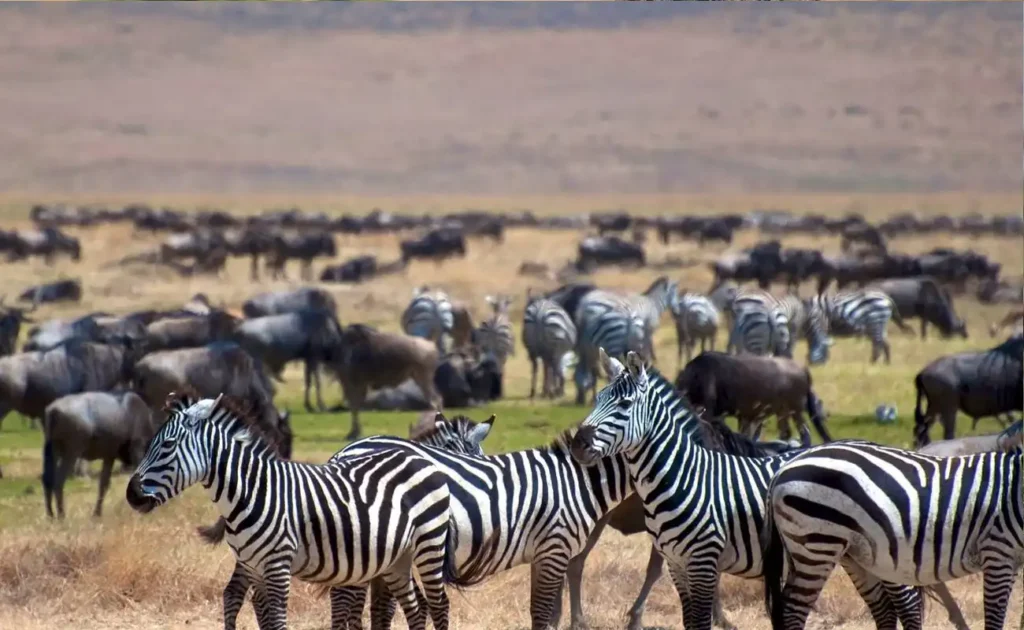The allure of the African wilderness takes on a whole new dimension with the advent of fly-in safaris in Tanzania. Consider traversing the sprawling Serengeti, witnessing the Great Migration from a vantage point few have experienced – the sky. This unique method blends the romance of traditional safari with the efficiency of modern travel.
Introduced to meet the growing demand for seamless and time-efficient exploration, fly-in safaris have roots in the logistical challenges of accessing remote parts of Tanzania. The shift from arduous road travel to these aerial excursions has been transformative; statistics suggest a two-fold increase in tourism over the past decade. Today, conservation and tourism intertwine, as this mode of travel promises minimal ecological impact while maximizing the reach of wildlife encounters.

Fly-in Safari Tanzania: An Overview
Fly-in safaris in Tanzania offer a thrilling way to explore the country’s stunning landscapes. Imagine soaring above the savannah and landing in the heart of the Serengeti. This method of travel allows tourists to witness the Great Migration from an aerial perspective, transforming the traditional safari experience. Additionally, it eliminates long road trips that can often be tiring. Comfort and convenience are key highlights of choosing this option.
Many travelers appreciate the unique comforts provided by fly-in safaris. This post indicates that the aerial view of vast wildlife habitats is a breathtaking experience not to be missed. Flights often operate from small airstrips near major attractions, ensuring travelers are never far from adventure. Moreover, it provides more time for game viewing, as transfers between parks are swift. This efficiency allows visitors to maximize their time in each location.
According to the article, fly-in safaris have adapted to meet the demands of modern tourism. Launched to provide seamless access to remote parts of Tanzania, they now play a critical role in tourism. As outlined [here](https://www.siasafaris.com/tour/3-days-fly-in-serengeti-and-ngorongoro-crater-safari/), there are multiple options for shorter or extended stays. Each journey promises unique wildlife sightings and unparalleled views. The promise of luxury remains tangible throughout.
Despite the growing popularity, fly-in safaris also emphasize eco-friendly travel. Tour operators strive to ensure minimal impact on sensitive environments, according to this article. By limiting ground disturbance, these tours help protect the natural habitats. This sustainable approach benefits wildlife conservation efforts while promoting responsible tourism. Engaging in these excursions supports a balanced ecosystem and a memorable adventure.
Evolution of Fly-in Safaris
Fly-in safaris have witnessed significant change since their inception. Initially, they were an exclusive means to explore the African savannah. These tours began as luxury options, catering to high-end tourists wanting quick access to remote areas. Over time, increased demand pushed operators to expand offerings. Today, it’s a more accessible adventure for many travelers.
Advancements in aviation technology played a huge role in transforming these safaris. Technical improvements have made small aircraft safer and more efficient. According to travel experts, this has allowed operators to reduce costs and enhance overall reliability. Resultantly, more tourists are able to enjoy adaptive safari experiences in distant regions. Convenient flights now transport visitors directly to wildlife hotspots.
Responding to increasing ecological awareness, fly-in safaris have embraced sustainability. Operators endeavor to protect the environment while providing an unforgettable experience. They focus on limited disturbance to wildlife and ecosystems. Initiatives often include using fuel-efficient aircraft and supporting local conservation programs. This approach supports responsible tourism while safeguarding natural habitats.
As the landscape of African tourism evolves, so does the scope of fly-in safaris. With continued growth in visitor numbers, adaptation remains crucial. Operators are now offering tailored packages to suit diverse interests and budgets. Options might include brief weekend trips or week-long explorations filled with game viewing. This flexibility ensures everyone can find a suitable safari adventure.
Reimagining Safari Travel
Safari travel has entered a new era where possibilities expand beyond traditional jeep tours. Today’s travelers crave unique experiences, leading to creative options such as hot air balloon rides and walking safaris. This evolution means visitors can enjoy Africa’s majestic landscapes in more diverse ways. With enhanced technology, even virtual reality safaris are emerging. These innovations allow a deeper connection with wildlife that fosters awareness and appreciation.
The changing preferences of tourists have also influenced safari operators to think outside the box. Companies now offer personalized itineraries and experiences, catering to individual desires and interests. Some include activities like cultural village visits and photographic safaris. This personalized approach ensures that each visitor’s journey is both memorable and fulfilling. By customizing itineraries, operators ensure that every safari experience is truly one-of-a-kind.
Sustainability is a key focus in reimagining safari travel, ensuring tourism supports rather than harms the environment. Eco-friendly safaris promote conservation and respect local communities’ needs. Common practices include using solar-powered lodges and biodegradable materials. Many companies also support conservation projects and educate travelers on environmental issues. This commitment is crucial in protecting Africa’s unique ecosystems and biodiversity.
Lastly, technology is transforming safari travel by enhancing safety and learning opportunities. Apps provide real-time information about animal sightings and weather conditions. Tour guides use GPS to navigate and track wildlife, ensuring guests have optimal viewing experiences. Moreover, informative mobile tools allow tourists to learn about species and conservation efforts. Embracing technology helps make safaris safer, more educational, and increasingly exciting.
The Destinations: Tanzania’s Wilderness Awaits
Tanzania is renowned for its breathtaking landscapes and wildlife-filled national parks. The Serengeti National Park is one of the most famous destinations, known for the Great Migration. This annual event sees millions of wildebeest and zebras move across the plains. Visitors can also encounter lions, elephants, and cheetahs. This post highlights the park’s significance.
The Ngorongoro Crater is another must-see destination in Tanzania. Formed by a collapsed volcano, it is home to diverse wildlife and impressive scenery. The crater offers an ecosystem that supports a variety of species in a confined space. Tourists can see black rhinos, hippos, and a host of birds. A visit to Ngorongoro promises unforgettable wildlife experiences.
For those seeking a more remote adventure, Ruaha National Park provides an ideal setting. It is Tanzania’s largest national park and sees fewer tourists, preserving its raw beauty. The park is famous for its vast elephant population and large pride of lions. It also hosts over 500 species of birds. This seclusion enhances the wilderness experience.
Selous Game Reserve offers a unique mix of riverine and land-based safaris. Visitors can glide along the Rufiji River, spotting crocodiles and hippos. The reserve also provides views of giraffes, buffaloes, and wild dogs. According to the article, it is one of the less crowded destinations, making it perfect for those desiring tranquility. This blend of water and land safaris sets it apart.
In contrast, Tarangire National Park is renowned for its baobab trees and large herds of elephants. The park’s landscape features swamps and rivers that attract numerous animals. Zebras, giraffes, and wildebeests are common sightings. Bird enthusiasts will appreciate the variety of species found here. Tarangire’s unique environment offers a distinct safari experience.
Environmental Considerations: Conservation and Tourism
Balancing tourism with conservation efforts is crucial in Tanzania. The stunning natural landscapes draw visitors from around the world, which can impact the environment. National parks and reserves impose strict guidelines to limit human interference. Visitors are encouraged to follow rules designed to protect wildlife and natural habitats. This helps maintain the ecosystem’s delicate balance.
Many safari operators adopt eco-friendly practices to reduce their carbon footprint. These efforts include using solar-powered lodges and eco-friendly transportation. By integrating sustainable practices, operators help preserve natural resources while offering unique safari experiences. Tourists are educated about conservation during their visits. This practice promotes awareness and responsibility in tourists.
Several organizations and initiatives work tirelessly to conserve Tanzania’s wildlife. They focus on protecting endangered species, such as the black rhino and African elephant. Funding from eco-tourism often supports these conservation programs. Tourists can directly contribute by choosing eco-friendly tours and making donations. Every effort counts in safeguarding these incredible creatures.
Sustainable tourism also means supporting local communities. Many operators employ local guides and staff, benefiting the economy. Cultural exchange programs offer visitors a chance to learn about indigenous cultures. These interactions foster mutual respect and understanding. Supporting community-based tourism is a meaningful way to contribute.
Regular monitoring and research are essential for effective conservation. Scientists track animal populations and study environmental changes to inform strategies. Data collection helps in making informed decisions regarding wildlife management. Collaborative efforts between governments, NGOs, and the tourism industry are vital. Together, they strive to create a sustainable future for Tanzania’s natural wonders.
Exciting Future for Fly-in Safari Tanzania
The future of fly-in safari in Tanzania looks promising with innovative strategies and offerings. Advances in aviation are making travel more accessible and comfortable. Eco-tourism initiatives continue to gain momentum, promoting sustainable travel options. New technologies like drones and VR are enhancing how tourists experience safaris. Increasing interest in conservation and wildlife preservation further supports this trend.
Customized safari packages are set to become more diverse and tailored. Operators listen to client feedback, creating bespoke itineraries. Options range from luxury lodges to budget-friendly camps, ensuring everyone can partake. Enhanced personalization means visitors can choose experiences that best match their interests. This flexibility is expected to attract a broader audience.
Sustainability will remain a key focus in the coming years. Current trends suggest more operators will adopt green practices. The use of solar-powered accommodations and electric safari vehicles are likely to increase. Tourists are increasingly choosing tours that emphasize eco-friendly practices. This commitment supports ongoing conservation efforts.
Community involvement is also predicted to grow. More partnerships between tour operators and local communities are emerging, offering mutual benefits. Locals gain employment opportunities and tourists enjoy authentic cultural interactions. Such programs cultivate a deeper understanding and appreciation of Tanzanian heritage. Empowering local communities is integral to sustainable tourism.
Exciting developments in technology are set to transform the safari experience. Real-time wildlife tracking apps could enable tourists to spot animals more easily. Virtual reality safaris might offer pre-trip previews or supplement physical tours. These innovations promise to make safaris more interactive and engaging. The blend of traditional adventure with modern tech heralds an exciting future.

Frequently Asked Questions
Fly-in safaris in Tanzania offer a unique way to explore the country’s stunning wildlife and landscapes. Here we answer some common questions about this thrilling travel option.
1. What is included in a fly-in safari package?
Most fly-in safari packages include flights between lodges, accommodation, meals, and guided game drives. These packages often provide a seamless experience, ensuring tourists have all essentials covered while exploring Tanzania’s national parks. Transfers are typically included to reduce travel-related stress and focus on enjoyment.
Accommodation ranges from luxury lodges to tented camps, catering to different preferences. Meals often feature local and international cuisines, offering a taste of Tanzania. Expert guides accompany game drives, enriching the experience with insights into wildlife behavior and local culture. This comprehensive approach ensures a memorable safari.
2. Why choose a fly-in safari over a traditional road safari?
Fly-in safaris offer quicker access to remote wildlife areas, maximizing time spent in the parks. This method reduces travel fatigue from long road trips, allowing for more relaxation and wildlife observation. Visitors can experience multiple parks in a short amount of time, enhancing the adventure.
Additionally, the aerial perspective provides unique views of Tanzania’s stunning landscapes. Tourists can witness geography changes, from open savannahs to lush craters, in a single journey. This offers a unique glimpse into the country’s diverse ecosystems, making the trip truly remarkable.
3. Are fly-in safaris eco-friendly?
Yes, fly-in safaris aim to minimize environmental impact through sustainable practices. Operators focus on using eco-friendly accommodations and energy sources, such as solar power, to reduce carbon footprints. This approach ensures that tourism activities support conservation efforts and protect Tanzania’s natural beauty.
Over-flying without landing excessively limits disturbance to wildlife habitats. By choosing eco-conscious operators, tourists can contribute to preserving ecosystems. Travel companies often partner with local conservation projects, channeling resources back into preserving the environment.
4. What wildlife can I expect to see on a fly-in safari?
Fly-in safaris expose travelers to Tanzania’s diverse wildlife, including the Big Five: lions, elephants, buffalo, leopards, and rhinos. These animals inhabit iconic parks like the Serengeti and Ngorongoro Crater. Additionally, visitors may encounter zebras, giraffes, and antelopes roaming widespread plains.
Bird enthusiasts will appreciate the vast species variety, particularly around water bodies. Specialists guide tourists to prominent birdwatching spots, offering chances to observe flamingoes, eagles, and other exotic birds. This wide array of wildlife viewing opportunities ensures excitement for nature lovers.
5. How can I prepare for a fly-in safari?
Preparation involves selecting suitable clothing for varying climates, such as layering options for cool mornings and warm afternoons. Neutral colors, like khaki and olive, are recommended for wildlife watching since they blend with the environment. Sunscreen, hats, and sunglasses protect against sun exposure.
Don’t forget to pack essential travel items, including a pair of binoculars and a camera with extra memory cards. Experienced tour operators often provide comprehensive packing lists to assist visitors. These preparations enhance the fly-in safari experience, ensuring comfort and readiness for unforgettable moments.



